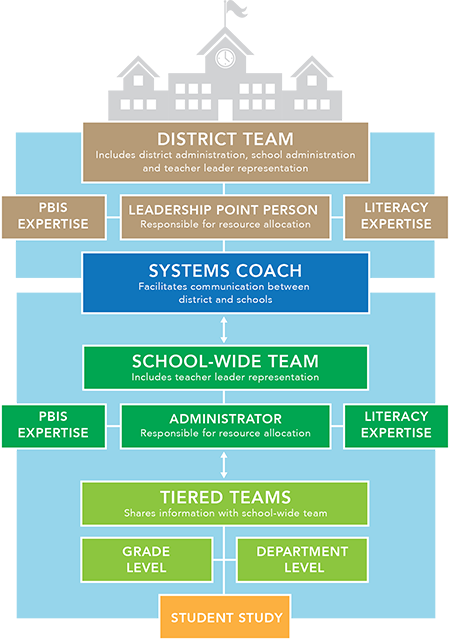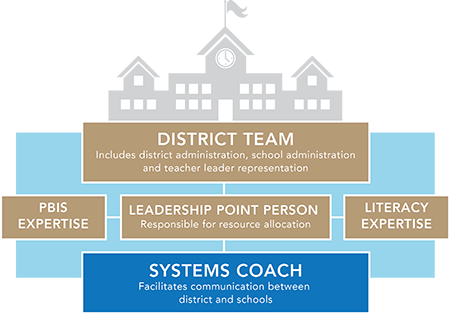Webinars to guide data teams available at the bottom of this page.
The EBISS Teaming Framework
“The principal goal of EBISS is the improvement of academic and behavioral student outcomes through the development of district capacity and the efficient use of district and building resources. Through the sustained application of a blended model of Response to Intervention (RTI) district staff is able to meet the academic and behavioral needs of every student in their schools.”
– EBISS
District Leadership Team
Recommended Membership
- EBISS Systems Coach: Facilities team
- EBISS Point Person: Someone with control of resources
- Literacy and Behavior Representatives
- Curriculum Director
- SPED Director
- Principal (at each level)
- School-wide- Team Facilitator (from at least one school)
Purpose
Oversee the implementation of an integrated, multitiered approach to:
- School-wide behavior model
- school-wide literacy model
- RTI SLD eligibility in elementary
Information Gathered
- System, process and outcome data in areas of reading and behavior
- School overall ODR data
- School fidelity data (SET, BoQ, PET-R)
- School action plans
- District systems support plan, team self-assessment, priorities and action plan
- Funding, visibility, political support
- Professional development
Example Activities
- Develop training calendar for professional development in area of PBIS, literacy and RTI
- Communicate with school board regarding progress in PBIS and literacy
- Consolidate initiatives to encourage blending and financial efficiency
School Leadership Team
Recommended Membership
- Principal
- Representative from:
- Grade Levels
- SPED
- ELL Programs
- Counseling
- Title I
Purpose
- Provide guidance with school-wide assessments, school action planning and implementation, and evaluation of the improvement process
- Communicate and celebrate with school and community
- Create school-wide action plan and supervise grade-level action plans and progress monitoring checklist
- Emphasis on prevention
Information Gathered
- System, process, and outcome data in areas of reading and behavior
- ODR Data
- Attendance
- Three times a year, team spends extended time (1/2 day) working with Literacy Benchmarking data
- Fidelity Data (SET, PET-R)
- Create school-wide action plan with PBIS and literacy emphasis
- Oversee and support grade level literacy and PBIS action plans
- Summary of progress monitoring data
Example Activities
- Write school improvement plan to focus on increasing number of student reading at grade level
- Guide staff in identifying, teaching, monitoring, and encouraging behavior expectations
- Plan Universal Literacy Screening
- Acquire curriculum instructional materials
Grade level teams
The Systems Coach supports building principals in the coordination of communication loops and improvement cycles.
- The Systems Coach assures there is clear, consistent and regular communication between school teams (e.g., grade level, content, targeted and individualized support teams) and that the information is feed forward to the SLT (BLT) and DLT.
Webinars
Scaling Up EBISS: Establishing Fidelity of Assessment Administration & Data Collection: Data Team Meetings Part 1
This webinar highlights the building level data team process. You will walk away with tools and strategies you can apply in your next data team meeting.
Scaling Up EBISS: Creating a Strategic Plan to Ensure Appropriate Use of Data: Data Team Meetings Part 2
This webinar builds upon the skills you gain from Part 1 and we will provide you a “real world” example of how a data team meeting looks at the school level.
Scaling up EBISS: The District Data Team Meeting: Blending PBIS and Academic Tiered Models of Support
This webinar Covers the District Data Team Meeting: Blending PBIS and Academic Tiered Models of Support.
Back to top.




